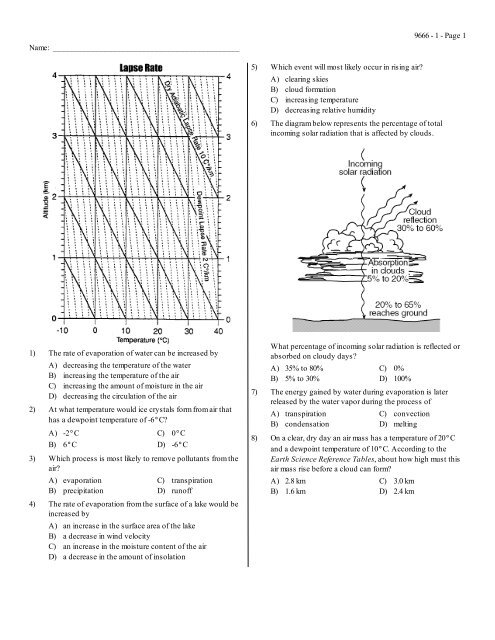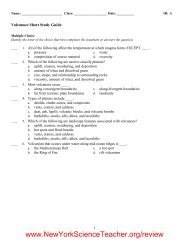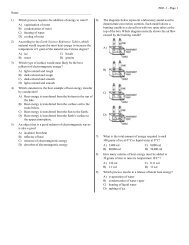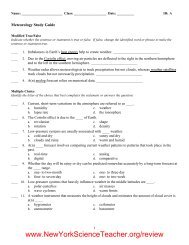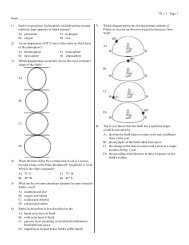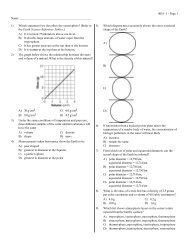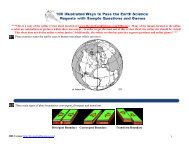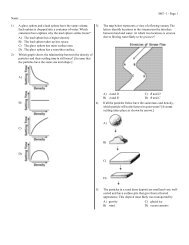Name - Earth Science Regents Review
Name - Earth Science Regents Review
Name - Earth Science Regents Review
- No tags were found...
Create successful ePaper yourself
Turn your PDF publications into a flip-book with our unique Google optimized e-Paper software.
<strong>Name</strong>: ____________________________________________9666 - 1 - Page 15) Which event will most likely occur in rising air?A) clearing skiesB) cloud formationC) increasing temperatureD) decreasing relative humidity6) The diagram below represents the percentage of totalincoming solar radiation that is affected by clouds.1) The rate of evaporation of water can be increased byA) decreasing the temperature of the waterB) increasing the temperature of the airC) increasing the amount of moisture in the airD) decreasing the circulation of the air2) At what temperature would ice crystals form from air thathas a dewpoint temperature of -6DC?A) -2DCC) 0DCB) 6DCD) -6DC3) Which process is most likely to remove pollutants from theair?A) evaporationB) precipitationC) transpirationD) runoff4) The rate of evaporation from the surface of a lake would beincreased byA) an increase in the surface area of the lakeB) a decrease in wind velocityC) an increase in the moisture content of the airD) a decrease in the amount of insolationWhat percentage of incoming solar radiation is reflected orabsorbed on cloudy days?A) 35% to 80%B) 5% to 30%C) 0%D) 100%7) The energy gained by water during evaporation is laterreleased by the water vapor during the process ofA) transpirationB) condensationC) convectionD) melting8) On a clear, dry day an air mass has a temperature of 20DCand a dewpoint temperature of 10DC. According to the<strong>Earth</strong> <strong>Science</strong> Reference Tables, about how high must thisair mass rise before a cloud can form?A) 2.8 kmB) 1.6 kmC) 3.0 kmD) 2.4 km
9) Which graph best represents the relationship between waterdroplet size and the chance of precipitation?9666 - 1 - Page 211) The graph below represents how the rate of evaporation ofwater is affected by a variable, X. Which variable is mostlikely represented by X?A)B)C)A) moisture content of the airB) temperatureC) exposed surface areaD) wind velocity12) The drawing below represents five positions of a balloonafter being released from a ship. The drawings of theballoon are not to scale compared to the altitude distances,but are to scale with each other.D)10) The diagram below shows the direction of movement of airover a mountain.As the air moves down the leeward side of the mountain,the air willA) warm due to expansionB) cool due to expansionC) warm due to compressionD) cool due to compressionWhy is the balloon's appearance at position E different fromthe balloon's appearance at position A?A) The outside air temperature is lower at E than at A.B) There is more gas inside the balloon at A than at E.C) There is a partial vacuum inside the balloon at A, butnot at E.D) The outside air pressure is lower at E than at A.13) Condensation of water vapor in the atmosphere is mostlikely to occur when a condensation surface is available andA) the temperature of the air is below 0DCB) the air pressure is risingC) the air is saturated with water vaporD) a strong wind is blowing
14) Which process most directly results in cloud formation?A) transpirationB) precipitationC) radiationD) condensation9666 - 1 - Page 315) A higher concentration of water vapor is found in theatmosphere over New York State in the summer than in thewinter because in the summer there is a greaterA) rate of evapotranspirationB) concentration of air pollutantsC) frequency of high pressureD) amount of water in ground storage16) The diagram below shows a common weather condition approaching a section of New York State.As the air moves from point D to point E, it will beA) cooled by compressionB) warmed by expansionQuestions 17 through 20 refer to the following:C) cooled by expansionD) warmed by compressionThe diagram below shows a mountain. The prevailing wind direction and air temperatures at different elevations on both sides of themountain are indicated.17) On which side of the mountain and at which elevation is therelative humidity probably 100%?A) on the leeward side at 1.0 kmB) on the windward side at 1.5 kmC) on the leeward side at 2.5 kmD) on the windward side at 0.5 km
18) The air temperature on the leeward side of the mountain atthe 1.5-kilometer level is higher than the temperature at thesame elevation on the windward side. What is the probablecause for this?A) Heat stored in the ocean keeps the windward side ofthe mountain warmer.B) The insolation received at sea level is greater on theleeward side of the mountain.C) The air on the windward side of the mountain has alower adiabatic lapse rate than the air on the leewardside of the mountain.D) Potential energy is lost as rain runs off the windwardside of the mountain.9666 - 1 - Page 419) How does the temperature of the air change as the air riseson the windward side of the mountain between sea level and0.5 kilometer?A) The air is warming due to expansion of the air.B) The air is warming due to compression of the air.C) The air is cooling due to expansion of the air.D) The air is cooling due to compression of the air.20) What would be the approximate air temperature at the top ofthe mountain?A) 10DCC) 4DCB) 12DCD) 0DCQuestions 21 through 25 refer to the following:Diagram A below represents the flow of air over a mountain. Diagram B shows the temperature of the ascending and descending air atvarious levels.21) At what location on the mountain is the relative humidityprobably 100%?A) on the windward side at 800 metersB) on the leeward side at 2,000 metersC) on the windward side at 2,500 metersD) on the leeward side at 500 meters22) Which statement best explains why clouds form at the1,600-meter level on the windward side of the mountain?A) The moisture in the rising air turned into a gas.B) The temperature of the rising parcel of moist air cooledbelow the dewpoint.C) The temperature of the rising parcel of moist air warmedabove the dewpoint.D) The rain from the clouds above was absorbed by therising air.23) What is the total increase in the temperature of the air as itdescends from the top to the base of the mountain?A) 22 CDC) 15 CDB) 27 CDD) 3 CD24) The air warms as it descends on the leeward side of themountain becauseA) air expands as it descendsB) more precipitation occurs on the leeward side of themountain than on the windward sideC) air is heated by the Sun at the top of the mountainD) air is compressed as it descends25) What is the approximate temperature of the descending airat an elevation of 1,600 meters?A) -12DCC) + 15DCB) +2DCD) -5DC


